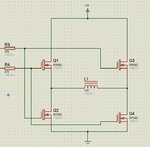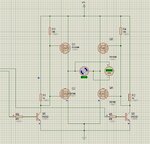faraj
Member level 1
- Joined
- Feb 22, 2005
- Messages
- 40
- Helped
- 1
- Reputation
- 2
- Reaction score
- 1
- Trophy points
- 1,288
- Location
- Azarbaijan/ Tabriz
- Activity points
- 1,601
hi everyone,
i'm working on a circuit in which i want to apply pulses to an inductive load. to produce pulses i'm using Power MosFET (IRF840). as the load is inductive i want to protect the mosfet against reverse current or what is so called. but my problem is that i'm applying pulses to the load in both directions not just one direction and in order to do this i'm using 4 mosfets to feed 1 load so i don't know where to put the protective circuit. i attach the circuit, i think it is much better than describing . first, i'll apply positive pulse (right-to-left) then a after an interruption i'll apply the negative pulse (left-to-right).
. first, i'll apply positive pulse (right-to-left) then a after an interruption i'll apply the negative pulse (left-to-right).
thank you in advance for your time and effort.
i'm working on a circuit in which i want to apply pulses to an inductive load. to produce pulses i'm using Power MosFET (IRF840). as the load is inductive i want to protect the mosfet against reverse current or what is so called. but my problem is that i'm applying pulses to the load in both directions not just one direction and in order to do this i'm using 4 mosfets to feed 1 load so i don't know where to put the protective circuit. i attach the circuit, i think it is much better than describing
thank you in advance for your time and effort.


